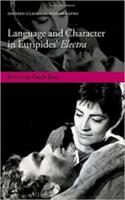
OUP (2017) h/b 319pp £75 (ISBN 9780198793601)
This is an important book. Students of Greek tragedy will be aware of the valuable work on women’s speech in Laura McClure’s Spoken Like a Woman and Judith Mossman’s CQ article, ‘Women’s Speech in Greek Tragedy’ (which centres on a scene from this play). What has so far been missing from the debate is a substantial book written by a fully-fledged philologist which brings to bear the criteria of modern linguistics on the way in which not just the women but all the characters in the play talk. This is that book. It is, I am relieved to say, easily comprehensible to the linguistic layman. The cover tells us that it applies to a single tragedy ‘a variety of modern linguistic theories—including conversation analysis, pragmatic, sociolinguistics (on gender and politeness), paroemiology, and discourse studies’. This may sound intimidating, but vEB. explains each of the concepts clearly and includes a lucid glossary of linguistic terms in case one forgets.
The author sets out to show how Euripides shapes his characters through their use of language, and in applying his methodology to a number of passages in which there are major textual issues he views such matters through a new lens. For example, he argues that the manuscripts are likely to be fundamentally correct in Orestes’ gnomic speech about the Autourgos and in two passages where the distribution of parts has been found problematic (671-85 and 959-87). He shows no fear in dissenting from some of the most respected of the poet’s textual critics and he is pretty persuasive, while his teasing out of the play’s characters from what they say is often illuminating and convincing.
It seems to me that there is just one problem in his approach. Concentrating on a number of isolated passages and in the process neglecting considerable chunks of the tragedy, he runs the danger of not paying attention to the broader context of the excerpts he discusses. He is certainly alive to the earlier pointers to the cataclysmic reversal when the siblings comprehend the horror of what they have done, but he does not always see how a previous scene may affect the way an audience will react to what the characters say in a later one.
For example, he is rightly eager to show that the Messenger speech is primarily an exciting narrative in which Orestes gets progressively closer to a position in which he can commit his murder, but he fails to see that the Messenger, even though he is a partisan of Orestes, brings out fully, at 779-92, the uncomplicatedly hospitable character of Aegisthus, observed too by the Old Man at 637, as vEB. himself notes. It may be hard for us to forget this admirable quality in Aegisthus when Electra pours out her loathing of him in her kakology. In a similar way, he does not observe that an audience reacting to the agon between Clytemnestra and her daughter will be aware that Electra has only been able to lure her mother out to her country home because she is sure that she cares enough about her to wish to assist her after she has given birth (656).
But these are niggles. vEB. has produced a masterful book. His successful application of a linguistic approach should open the gateway to much valuable appreciation of the tragedies in the future. We should be most grateful to him.
James Morwood—Wadham College, Oxford
